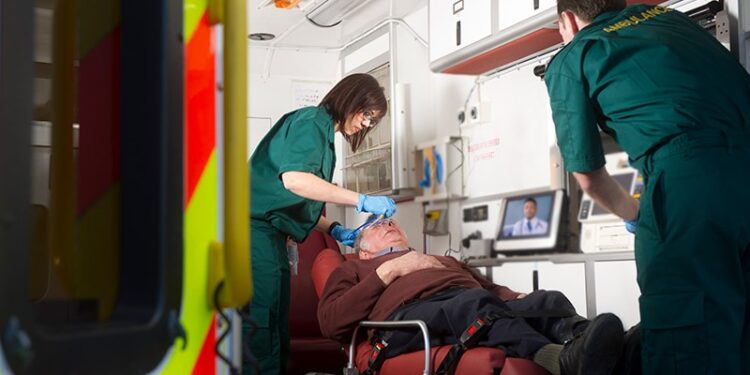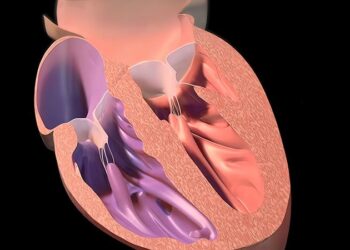HELSINKI, Finland — Using telemedicine-based neurologist assessments in mobile stroke units proves to be safer and more resource-efficient than using traditional models in which a neurologist is on board the ambulance, new research shows.
The trial, conducted across 10 tertiary hospitals in Melbourne, Australia, is the first prospective, head-to-head comparison of these two models of stroke care delivery.
“There’s been a long-standing assumption that having a neurologist physically on board is the gold standard for mobile stroke unit care, but our trial shows that telemedicine delivers comparable outcomes in key operational domains,” said principal investigator Vignan Yogendrakumar, MD.
Although the median time from arrival on scene to treatment decision was about 4 minutes longer in the telemedicine arm, this was deemed to be offset by a significant reduction in resource use.
Among the 18% of patients who received thrombolysis or were transported for endovascular therapy, there was no difference in functional outcomes at 90 days.
“When we put everything together, we found that there was no difference in safety between the telemedicine and neurologist on-board arms. There was a small difference in the time position favoring the on-board arm, but there was significant resource utilization favoring the telemedicine arm.
“So the overall evaluation favors the telemedicine arm when it comes to balancing resource utilization with time to treatment and safety,” Yogendrakumar, assistant professor at the University of Ottawa, Ottawa, Ontario, Canada, and a senior research fellow at the University of Melbourne, Melbourne, Australia, told Medscape Medical News.
The findings of the MSU-TELEMED trial were presented on May 23 at European Stroke Organization Conference (ESOC) 2025.
Hierarchical Composite Outcome
Yogendrakumar noted that telemedicine is the standard practice across many healthcare systems worldwide and is widely used for acute stroke management in hospital emergency departments. However, until now, there was no formal head-to-head comparison between telemedicine and models that rely on an onboard neurologist in mobile stroke units.
The MSU-TELEMED trial assessed whether a telemedicine neurologist model can provide superior resource efficiency without compromising safety or timely delivery of care than a traditional on-board model of care.
The prospective, randomized, open-label, blinded endpoint, parallel-arm trial enrolled 275 patients with suspected stroke who presented to a mobile stroke unit within 24 hours of symptom onset or last known well and who had undergone a full assessment by mobile stroke unit staff.
The study used a single mobile stroke unit active in Melbourne, which could take patients to 10 different receiving hospitals. The randomization was done by day, so on some days the mobile stroke unit would have a neurologist on board, and on other days it would operate with a telemedicine service communicating with a neurologist at the main hospital.
The researchers used a hierarchical composite outcome that integrated safety, time to treatment decision, and resource efficiency. They applied a win-odds approach, which allows multiple outcomes to be assessed at different levels of priority by comparing each patient with every other patient in the study.
Safety was the first priority outcome. For each patient comparison, researchers determined whether a safety event had occurred — such as symptomatic hemorrhage or any form of clinical deterioration — which was then counted as a win or loss for either the telemedicine or onboard intervention.
If no safety event occurred, the next endpoint — time to treatment decision — was evaluated. A difference of 15 minutes or more between interventions was considered a win or loss for the corresponding group.
Time to Thrombolysis
If there was no meaningful difference in time to treatment decision, the final endpoint — resource utilization — was assessed. This was measured by the productive percentage time, defined as the time actively spent caring for the patient divided by the total time dedicated to the case. A difference of more than 10% in favor of one group was considered a win for that intervention and a loss for the other.
Finally, if there was no difference in productive percentage time between the two arms in a given pairwise comparison, the result was considered a tie. The overall findings were then summarized using a win-odds measure — the odds that a participant in the telemedicine arm would have a better outcome than the one in the on-board arm.
Results showed a number/proportion of telemedicine wins of 14, 618 (76%); ties occurred in 692 cases (4%) and on-board wins in 3590 cases (20%), giving a stratified win odds of 3.5 (95% CI, 2.4-5.1; P < .001).
More specifically, safety events occurred in 17 patients in each group — 13% in the telemedicine group vs 12% in the on-board group.
The median time from arrival on scene to a definitive treatment decision was 19 minutes in the telemedicine group vs 13 minutes in the on-board group.
In addition, the percentage of neurologist “productive” time was 100% in the telemedicine group vs 33% in the on-board group.
Of the 275 participants in the trial, about half were ultimately diagnosed with an ischemic stroke. Among those who received thrombolysis, the median time from arrival on scene to needle was 8.2 minutes longer in the telemedicine group.
“While every minute delay is important, this is a relatively small proportion of the time saved by mobile stroke unit care and needs to be balanced against the efficiency advantages achieved,” said Yogendrakumar.
“We were able to show that a telemedicine model is better able to utilize resources without sacrificing safety or delivery of care, and that will likely translate to cost savings,” he added.
A formal cost-effective analysis from this study is planned.
A Safe, Effective, Efficient Model
Yogendrakumar suggested that these findings could help inform the design of stroke care systems in various regions. For example, in Melbourne, a second mobile stroke unit is now being introduced, with both units connected via telemedicine to a single neurologist.
During the discussion following the MSU-TELEMED trial presentation, Guillaume Turc, MD, professor of neurology at Sainte-Anne Hospital in Paris, France, praised the study’s innovative design, particularly its use of a hierarchical outcome structure and the win-ratio method.
He noted that the findings were highly positive, supporting the safety of telemedicine-based neurologist assessments and highlighting their greater efficiency in resource use.
Simona Sacco, MD, professor of neurology at the University of L’Aquila in L’Aquila, Italy, and current president of the European Stroke Organisation, added that this approach could be especially valuable in rural areas, where staffing ambulances with neurologists is often a significant challenge. She described the study as a welcome development and an important advancement in the field.
The MSU-TELEMED trial was funded by grants from the Sylvia and Charles Viertel Charitable Foundation and the Medical Research Future Fund “Golden Hour” Frontiers grant. Yogendrakumar reported having no disclosures.
Source link : https://www.medscape.com/viewarticle/teleneurology-bests-onboard-ambulance-stroke-care-model-2025a1000esk?src=rss
Author :
Publish date : 2025-06-02 10:14:00
Copyright for syndicated content belongs to the linked Source.














